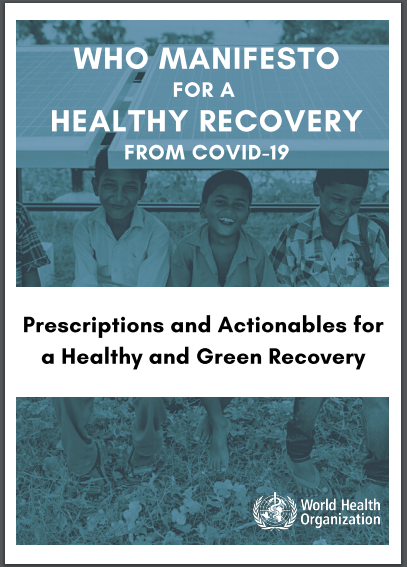WHO prescription 4: Promote healthy, sustainable food systems
Diseases caused by either lack of access to food, or consumption of unhealthy, high calorie diets, are now the single largest cause of global ill health. They also increase vulnerability to other risks - conditions such as obesity and diabetes are among the largest risk factors for illness and death from COVID-19.
Agriculture, particularly clearing of land to rear livestock, contributes about ¼ of global greenhouse gas emissions, and land use change is the single biggest environmental driver of new disease outbreaks. There is a need for a rapid transition to healthy, nutritious and sustainable diets. If the world were able to meet WHO’s dietary guidelines, this would save millions of lives, reduce disease risks, and bring major reductions in global greenhouse gas emissions.
Actionables
- Develop or update national food-based dietary guidelines through the full integration of environmental sustainability elements in each of the guideline’s recommendations, according to national contexts.
- Strengthen local food production and processing, especially by smallholder and family farmers, where appropriate.
- Promote diets which are based on a variety of unprocessed or minimally processed foods, include wholegrains, legumes, nuts and an abundance and variety of fruits and vegetables and which can include moderate amounts of eggs, dairy, poultry and fish, and small amounts of red meat.
- Promote the diversification of crops including underutilized traditional crops, applying sustainable food production and natural resource management practices.
- Consider use of trade policy, including instruments such as tariffs and quotas, to improve sustainable food supply.
- Implement policies and actions to create healthy, safe and sustainable food environments (such as strengthening of food control systems, restricting marketing of foods contributing to unhealthy unsustainable diets, nutrition labelling policies, fiscal policies, public food procurement policies, reformulation to gradually reduce saturated fat, sugars and salt/sodium and trans-fat from foods and beverages).
- Improve storage, preservation, transport, and distribution technologies and infrastructure to reduce seasonal food insecurity, food and nutrient loss and waste.
- Preserve fish habitats and promote sustainable fisheries.
Resources and links
UN Decade of Action on Nutrition 2016-2025
WHO Global Nutrition Targets 2025: Policy brief series
WHO Double-duty actions for nutrition: policy brief
Hazard Analysis and Critical Control Point (HACCP) system
WHO Five keys to safer food manual
Policy Brief: The Impact of COVID-19 on Food Security and Nutrition


